Abstract
This study aims to clarify the temperature-dependent degradation mechanisms of the steel–concrete interface in NaCl solution environments at the nanoscale, focusing on the key components of calcium silicate hydrate (C-S-H, the primary hydration product of cement) and iron oxyhydroxide (γ-FeOOH, a critical component of steel passive films in highly alkaline environments). Using Materials Studio software (2023) and molecular dynamics simulations, the evolution of the interface’s performance under temperatures ranging from 300 K to 390 K (corresponding to 27 °C to 117 °C) is systematically investigated. The results reveal that elevated temperatures degrade the performance of C-S-H/γ-FeOOH interfaces through three main mechanisms: (1) The stability of the hydration shell around aggressive ions is weakened, enabling these ions to occupy the coordination positions of calcium ions on the interface and form stable ion pairs with surface calcium ions, thereby weakening interfacial bonding. (2) The mobility of surface calcium ions is enhanced, reducing the strength of the interaction of ion pairs and diminishing the mediating role of calcium ions in connecting the C-S-H and γ-FeOOH phases. (3) Hydrogen bond stability at the interface decreases, as indicated by reduced hydrogen bond angles and numbers, coupled with increased hydrogen bond lengths. The above three reasons lead to a decrease in adsorption energy in the C-S-H/γ-FeOOH interface, which degrades the interface bond’s performance.
1. Introduction
In coastal, de-icing salt, and tropical hot–humid environments, steel fiber-reinforced concrete (SFRC) structures are subjected to long-term coupled effects of chloride ion attack and significant temperature fluctuations, leading to exacerbated problems of steel corrosion and degradation in durability [1,2,3]. Steel corrosion is an intricate electrochemical process closely associated with temperature, solution pH, and harmful ion concentrations [4,5]. Within concrete, the dense oxide layer on steel surfaces, i.e., the passive film, is formed; however, microcracks or macrocracks in the passive film are induced by long-term stress, and these provide channels for the chloride’s ingress and then accelerate corrosion’s initiation and propagation [6]. Elevated temperatures intensify ion migration rates, significantly accelerating chemical reaction kinetics [7], and the reduction in strength at elevated temperatures is associated with the continuous degradation of the main hydration product [8]. Therefore, a systematic investigation is imperative to elucidate the temperature-dependent performance degradation mechanisms of the steel–concrete interface under NaCl solution environments.
Regarding the effects of temperature on chloride’s ingress and steel fiber corrosion, previous studies [9,10,11,12,13] have proved that temperature rises significantly accelerate the diffusion rate of chloride ions and the corrosion rate of steel fiber, as well as increasing the electrical conductivity of steel bars. For example, Jin et al. [9] proposed a 3D microscopic numerical model for chloride diffusion in concrete, and it was shown that as the temperature increased from 0 °C to 35 °C, the chloride diffusion depth could increase from 41 mm to 89 mm. It was also proved that a temperature rise could accelerate the cement’s hydration and then decrease the porosity of the concrete to slow down the chloride diffusion; however, the temperature rise accelerates the movement of ions. In general, the chloride’s ingress would be accelerated by the increasing temperature. Alizade et al. [10] found that a humid–hot environment significantly accelerated the corrosion rate of steel fibers, decreasing the mechanical properties of steel fiber-reinforced concrete. Within the temperature range of 200 °C to 800 °C, the tensile strength of steel fiber decreased by approximately 15% for every 200 °C increase in temperature [11], while the compressive strength of SFRC decreased by 21.76% when the temperature increased from 400 °C to 800 °C [12]. Yang et al. [13] found that temperature not only accelerates chloride diffusion but also alters the pore structure of concrete through thermal-induced microcracking, further facilitating ion transport.
In terms of concrete, the key component is the cement, and the primary hydration product of cement is calcium silicate hydrate (C-S-H) gel, which constitutes approximately 70% of the total volume of cement hydration products and provides the main source of the chemical binding force in concrete [14]. C-S-H is a porous material with capillary pores ranging from the micron to the nanometer scale (e.g., 0.5 to 10 nm [15]). At the same time, the passive film on steel reinforcements and fiber, which is primarily composed of γ-FeOOH, is a critical barrier against corrosion, and it is also within the nanometer scale, with a thickness of 3 to 5 nm [16]. However, due to size limitations, experiments, even with the aid of microscopic techniques, can characterize the macroscopic diffusion behavior of chloride ions and the evolution of the passive film’s composition, but they are unable to capture the dynamic processes of ion migration, the fracturing of interface chemical bonds, and the temperature-driven initiation of microcracks. Molecular dynamics (MD) simulation provides a nanoscale perspective for analyzing the above multi-physics coupling problems. Thus, it is vital to conduct molecular dynamics simulations to give nanoscale insights into the temperature-driven degradation mechanisms of the C-S-H and the γ-FeOOH in NaCl solution environments.
Based on the molecular dynamics simulations, the diffusion or absorption capacities, as well as the temperature-driven degradation mechanisms, in C-S-H or γ-FeOOH have been studied. C-S-H, as the main component of cement hydration products, has been investigated by previous studies for its nanoscale properties, including chloride transportation and temperature-driven degradation mechanisms. In the study of Deng and He [17], tobermorite and jennite models were combined to represent the C-S-H, in which a Ca/Si ratio gradient microstructure design was proposed to delay the chloride ions’ ingress. With the aid of molecular dynamics, Wang et al. [18] found that by increasing the temperature from 300 K to 390 K, the transport of water in the C-S-H was increased, while the transport rate of sodium and sulfate ions was significantly reduced due to the formation and adsorption of ionic clusters on the C-S-H channel. Fei et al. [19] investigated the micro/nano mechanism of the adsorption characteristics for chloride ions in the C-S-H, which showed that increasing the temperature decreased the Ca2+ concentration and pH value, as well as the constraints of the gel on ions, and then reduced the chloride ion adsorption. Tong et al. [20] conducted molecular dynamics simulations to analyze the effects of temperature on water density, chemical bonds of ionic pairs, flow velocity distribution, and slip length during the flow process within the C-S-H nanopores. It was indicated that the temperature rising from 280 K to 360 K significantly increased the cross-sectional flow velocity within the nanopores. Im et al. investigated [21] the temperature effects on the local structure and mechanical properties of synthetic C-S-H. It was found that in the dehydration stage, with the temperature beyond 105 °C, thermal-induced evaporation of free water created additional pores, leading to irregular deformation of C-S-H under load. Wang et al. [22] conducted molecular dynamics simulations on C-S-H composites and revealed that both bulk modulus and shear modulus of C-S-H decreased with increasing temperature, and the temperature sensitivity was closely related to its Ca/Si ratio, i.e., C-S-H with a higher Ca/Si ratio showed more pronounced degradation in mechanical properties under elevated temperatures. Meanwhile, molecular dynamics simulations of γ-FeOOH (the main component of the passive film) are also conducted to investigate ion transport [23] and the temperature effects [7]. Tu et al. [23] employed molecular dynamics to analyze the transport of NaCl, Na2SO4, and their mixed solution in C-S-H gel and γ-FeOOH nanopores, which illustrated that ion diffusion is slower in γ-FeOOH nanopores than in C-S-H gel due to the high hydrophilicity of the C-S-H. In the study of Wu et al. [7], the temperature effects on sodium chloride solution adsorption in γ-FeOOH nanopores were discussed. It was found that the elevated temperatures enhanced ion diffusion and the adsorption capacity of γ-FeOOH pores for ions, as a result of the weakened Na-Ow (water oxygen) and Cl-Ow interactions and the strengthened Na-Cl, Na-Oh (hydroxyl oxygen), and Cl-Ho (hydroxyl hydrogen) ion pair interactions due to the high temperatures.
Except for the C-S-H and the γ-FeOOH, the steel–concrete interface is the key factor contributing to early depassivation and expedited corrosion propagation of steel rebar. For example, Tian et al. [24] researched the quantitative relationship between the microstructure of the steel–concrete interface and the corrosion rate and proved that the porous microstructure could be significantly attributed to the corrosion’s initiation. Results showed that the distribution of pore solutions played a crucial role in the degradation of the steel–concrete interface, and in unsaturated conditions, the steel–concrete interface factor and the degree of saturation were related by a power empirical function. Hence, molecular dynamics simulations are also conducted on the C-S-H/γ-FeOOH interface. Hou et al. [25] explored the interface between the passive film and cement hydrate in reinforced concrete, focusing on the bonding mechanism and the impact of water. Results showed that calcium ions and hydroxyl groups strengthened the interlayer bond, but water, especially double-layer water, weakened the interfacial connections and reduced the mechanical properties. In the study of Zhang et al. [26], the bond behaviors and mechanical responses of the γ-FeOOH/C-S-H interface under the aggressive environments of dry, water, NaCl, Na2SO4, and NaCl + Na2SO4 conditions were discussed. It was concluded that water molecules and aggressive ions (Na+, Cl−, and SO42−) weakened the interfacial bond. Water formed new bonds that replaced the original ones between γ-FeOOH and C-S-H, while aggressive ions accumulated on the C-S-H surface, interfering with the interfacial bond. However, there is a dearth of data available on the temperature-driven degradation mechanisms of the C-S-H/γ-FeOOH interface in NaCl solution environments.
Therefore, in this study, molecular dynamics simulations are used to discuss the temperature-driven degradation mechanisms of the C-S-H/γ-FeOOH interface in NaCl solution environments, in which the temperatures are set at 300 K (26.85 °C), 330 K (56.85 °C), 360 K (86.85 °C), and 390 K (116.85 °C). According to the ionic strength distribution, kinetic characteristics, and local structure at the above temperatures, the physical and chemical interactions in the C-S-H/γ-FeOOH interface are discussed at the nanoscale. This work will fill a research gap regarding the temperature-driven degradation mechanisms of the C-S-H/γ-FeOOH interface in NaCl solutions, and it provides a microscopic scientific basis for understanding the degradation in durability of SFRC under chloride ion attack and temperature fluctuations.
2. Simulation Method
2.1. Model Construction
In this study, the C-S-H and the γ-FeOOH models are established initially to present the model validation due to the dearth of data available about the performance of the C-S-H/γ-FeOOH interface, and then the C-S-H/γ-FeOOH interface model is built to analyze its temperature-driven degradation mechanisms in the NaCl solution environments.
For the C-S-H, 11 Å tobermorite is adopted in this study as the original structure, and modeling calculations are carried out in the Materials Studio Software. The calcium–silicon ratio of the original structure is 1, which does not conform to the common calcium–silicon ratio of C-S-H gel, and hence, in this study, the C-S-H gel refers to the modeling method in the literature [27] as follows. Firstly, the monoclinic unit cell of the original structure is transformed into an orthorhombic unit cell through coordinate vector transformation. By expanding the unit cell, a structure with lattice parameters a = 22.32 Å, b = 22.17 Å, c = 22.77 Å, and α = β = γ = 90° is obtained. Then, all the interlayer water molecules and hydroxyl groups are removed (Figure 1a). Subsequently, silicates at the bridging positions are randomly removed to match the calcium–silicon ratio and Qn distribution obtained from the nuclear magnetic resonance of C-S-H (Figure 1b). Next, the Grand Canonical Monte Carlo (GCMC) method is used to simulate the water absorption of the structure until saturation (Figure 1c). Finally, the structure is relaxed for 100 ps under the NVT ensemble to make the system reach an equilibrium state, and the final C-S-H gel model is obtained (Figure 1d). At this time, the calcium–silicon ratio of the C-S-H gel model is 1.71, the Qn distribution is Q0 = 13%, Q1 = 67%, Q2 = 20%, and the density is 2.39 g/cm3, which is in good agreement with the research results of previous studies [28], indicating the rationality of the C-S-H model.
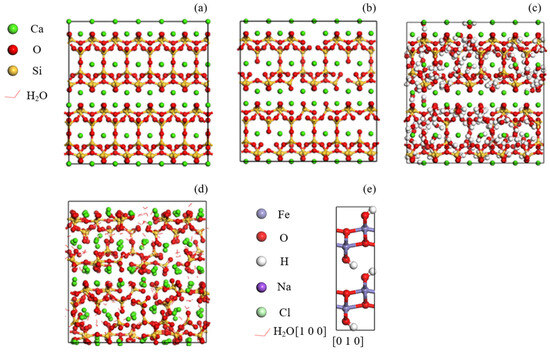
Figure 1.
C-S-H and γ-FeOOH model: (a) Removal of interlayer water molecules and hydroxyl groups. (b) Random removal of bridging silicates to match the target Ca/Si ratio and Qn distribution. (c) Water adsorption simulation. (d) Molecular structure of C-S-H. (e) Molecular structure of γ-FeOOH.
In terms of the passive film, as mentioned earlier, the existing works of literature [29,30] have shown that the main component of the passive film in a highly alkaline environment is γ-FeOOH, and γ-FeOOH has two space group structures, namely Cmcm and Cmc2. According to the research of Christensen H and Christensen A N [31], compared with the space group Cmcm, the space group Cmc2 can more accurately reflect the relevant properties of γ-FeOOH. The crystal structure parameters of γ-FeOOH with the space group Cmc2 are as follows: a = 3.08 Å; b = 12.50 Å; c = 3.87 Å; α = β = γ = 90°. The [0 1 0] direction of the crystal structure is chosen here to serve as the surface of the passive film model, as depicted in Figure 1e. The structure in this direction shows a layered characteristic, with hydrogen bonds formed between layers through hydroxyl groups. The results show that the adsorption energy of the solution on each layer is −1171.8 ± 10 Kcal/mol, indicating that the relationship between the adsorption energy and the substrate thickness is convergent; that is, the molecular dynamics model of the passive film in this study is reasonable.
Based on the above models for the C-S-H and γ-FeOOH, the C-S-H/γ-FeOOH model is established consisting of C-S-H, solution, γ-FeOOH, solution, and C-S-H, to investigate the influence of different temperatures on the interactions at the C-S-H/γ-FeOOH interface in the NaCl solution environment. Figure 2 shows the C-S-H and γ-FeOOH interface model, and the pore width of the solution region is set to 8 Å. Additionally, as shown in Figure 2, 20 Na ions, 20 Cl ions, and 549 water molecules are added into the nanopore to simulate a 2.0 mol/L NaCl solution at the interface.
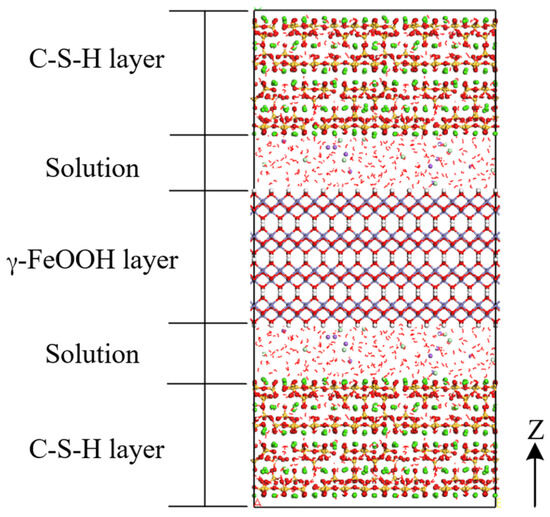
Figure 2.
C-S-H and γ-FeOOH interface model.
2.2. Force Field and Molecular Dynamics Algorithm
In this study, the interactions between the solution and the C-S-H gel, and the solution and the γ-FeOOH, as plotted in Figure 2, are described by the Clayff force field, which has been proven to be able to simulate the interaction relationship in cement and passive film [23,32], and related parameters regarding the force field are listed in Table 1.

Table 1.
Force field parameters of related atoms in the Clayff force field.
The molecular dynamics algorithm is employed as follows. First, perform geometric optimization to achieve energy minimization of the structure. Next, under the isothermal-isobaric ensemble (NPT) conditions at 300 K and 101.3 kPa, relax the structure for 30 ps to attain thermodynamic equilibrium. Finally, conduct 100 ps molecular dynamics simulations using the canonical ensemble (NVT) at temperatures of 300 K, 330 K, 360 K, and 390 K. The simulation time step is set to 1 fs, with data output every 100 steps, to investigate interfacial properties, diffusion behavior, dynamic characteristics, and interparticle interactions of the system under different temperatures.
3. Results and Discussions
3.1. Adsorption Properties
Figure 3 depicts the chloride ion distribution along the Z-axis (ranging from 15 Å to 45 Å) within the nanopore model, showing the influence of temperature on the chloride adsorption properties at the interfaces of C-S-H and γ-FeOOH. Firstly, elevated temperatures increase chloride ion peak intensities at both the C-S-H and γ-FeOOH interfaces, with a more pronounced enhancement observed at the γ-FeOOH interface compared to the C-S-H gel. For example, within the measured distance range, the peak intensity for 390 K at the γ-FeOOH interface is notably higher compared to 300 K, while the increment at the C-S-H interface is relatively less steep. This indicates that high temperatures indeed promote the adsorption of chloride ions by the matrix. The passive film (γ-FeOOH), in particular, exhibits a remarkable enhancement in chloride adsorption capacity with increasing temperatures. This conclusion agrees with a previous study [33] on the temperature-dependent behavior of chloride ion migration, in which, when the temperature increases from 0 °C to 35 °C, the diffusion depth of chloride ions substantially increases from 41 mm to 89 mm.
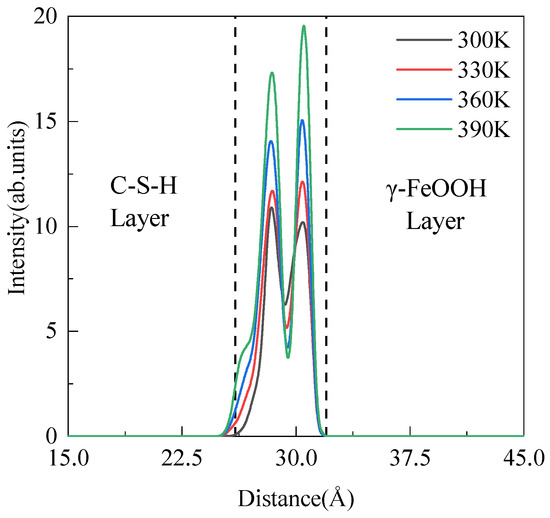
Figure 3.
Chloride ion distribution along the Z-axis (15 Å to 45 Å) within the nanopore model.
Secondly, the chloride intensity profile shifts toward the C-S-H gel layer under thermal effects, accompanied by partial chloride penetration into the C-S-H structure. At a temperature of 300 K, the chloride ion distribution is more concentrated near the γ-FeOOH interface than at a temperature of 390 K. Meanwhile, as the temperature increases, there is a clear trend of the distribution spreading towards the C-S-H layer, suggesting that thermal energy facilitates the movement of chloride ions from the outer regions towards the C-S-H gel. This penetration may disrupt the internal structure of the C-S-H gel to some extent and potentially affect its mechanical and chemical properties. Notably, across all the measured temperatures of 300 K to 390 K, there is no observable tendency of chloride ions to intrude into the γ-FeOOH layer at its surface. The intensity profiles near the surface of the γ-FeOOH layer remain relatively stable, indicating that the passive film serves as an effective barrier against chloride-induced steel corrosion. This is crucial because, before the degradation of the passive film (represented by the γ-FeOOH in this study), its integrity can prevent chloride ions from directly reaching the steel substrate, thereby safeguarding the steel from corrosion and prolonging the service life of the reinforced concrete structure.
In summary, the findings of this study indicate that an increase in temperature not only enhances the chloride adsorption capacity of the C-S-H/γ-FeOOH interface (with the enhancement at the γ-FeOOH interface being particularly significant) but also promotes the diffusion and penetration of chloride ions toward the C-S-H gel layer, without causing significant intrusion into the interior of the γ-FeOOH surface layer. This phenomenon clarifies the migration path of chloride ions at the interface under high-temperature conditions, demonstrating that γ-FeOOH, acting as a passive film, can effectively inhibit chloride-induced corrosion of steel bars. Meanwhile, it fills the research gap left by previous studies [25,26] regarding the influence of temperature on chloride ion behavior.
3.2. Local Structural Properties
The radial distribution function (RDF) is a statistical function used to describe the spatial distribution of particles in a system. In the context of analyzing ionic pair interactions, a higher RDF peak value indicates a stronger interaction strength between ions within a specific distance range, signifying a higher probability of attractive interactions between ionic pairs. Meanwhile, the further the peak position of the RDF extends, the more pronounced the spatial correlation between ionic pairs.
3.2.1. NaCl Solution
Figure 4 presents the radial distribution functions (RDFs) of ions in the solution to analyze the effect of temperature elevation on the local structure of NaCl solution at the interface, including the Na-Cl ion pairs, the Na-Ow, and the Cl-Ow. As shown in Figure 4a (i.e., the Na-Cl ion pairs), the short-range interaction peak, which is located at 2.8 Å (the first peak position) and represents the interaction between Na and Cl ions, shows a clear upward trend with the increase in temperature. This is because higher temperatures provide more kinetic energy to the ions, and then, the ions move more freely, reducing the influence of the hydration shell around them. As a result, the probability of direct contact between Na and Cl ions becomes significant, leading to an enhancement in the short-range interaction peak, which directly corresponds to an increase in the formation of Na-Cl ionic pairs. Conversely, the medium-range interaction peak, which is centered at 4.8 Å (the second peak position), decreases as the temperature goes up, which is associated with the Na-Ow-Cl hydration structures. To analyze the stability of the hydration structure, Figure 4b,c respectively display the RDF of Na and Cl ions with Ow in water molecules. It can be observed that as the temperature rises from 300 K to 390 K, the interaction intensities of both Na-Ow and Cl-Ow decrease. For a low temperature, the hydration shell is relatively stable, and the ions interact through the water molecules in the hydration shell, resulting in a relatively high peak value. However, as the temperature rises, the increased thermal motion disrupts the hydration shell, weakening the Na-Ow-Cl hydration structures. Consequently, the intensity of the medium-range interaction peak decreases, indicating that elevated temperatures destabilize the ion hydration structures.
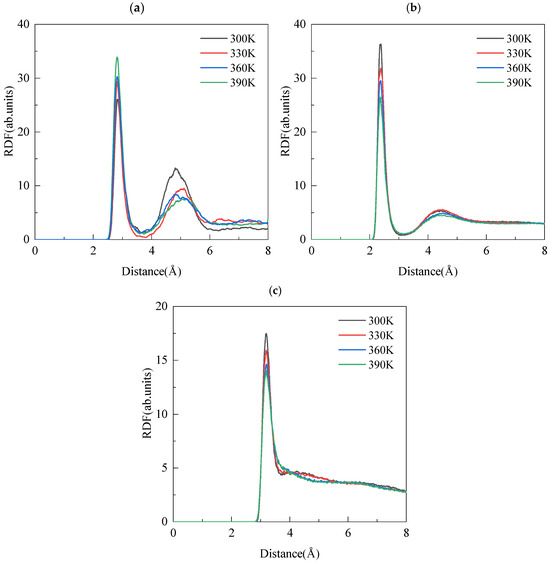
Figure 4.
Radial distribution function of solution ions. (a) Na-Cl pairs; (b) Na-Ow pairs; (c) Cl- Ow pairs.
Hence, the increases in the short-range and the decreases in medium-range interaction peaks with temperature demonstrate that an increasing temperature affects the local structure of the NaCl solution at the interface by destabilizing ion hydration structures and increasing the likelihood of direct ion-to-ion contact.
3.2.2. Interfacial Solution and the Matrix
Figure 5 presents the radial distribution function (RDF) curves depicting the interactions between ions in the interfacial solution and the solid matrix. Figure 5a,b show the RDF curves between sodium ions (Na) and the bridging oxygen (Os) on the C-S-H gel surface and the hydroxyl oxygen (Oh) on the γ-FeOOH surface, respectively. As the temperature increases, the interaction peaks between Na and Os rise, with the increase in the peak value of the first peak position of Na-Oh being significantly greater than that of Na-Os. That is, in the temperature range of 300 K to 390 K, the temperature increase significantly increases the adsorption capacity of γ-FeOOH for sodium ions, and this increase is greater than that of C-S-H for sodium ions. Figure 5c,d display the RDF curves between Cl and the surface calcium ions (Cas) in C-S-H gel and the Ho in γ-FeOOH, respectively. As the temperature rises from 300 K to 390 K, the short-range (2.3 Å) interaction strengths of Cl-Cas and Cl-Ho increase. Meanwhile, for the medium-range interactions, temperature increases rarely affect Cl-Cas but present a significant promoting effect on Cl-Ho.
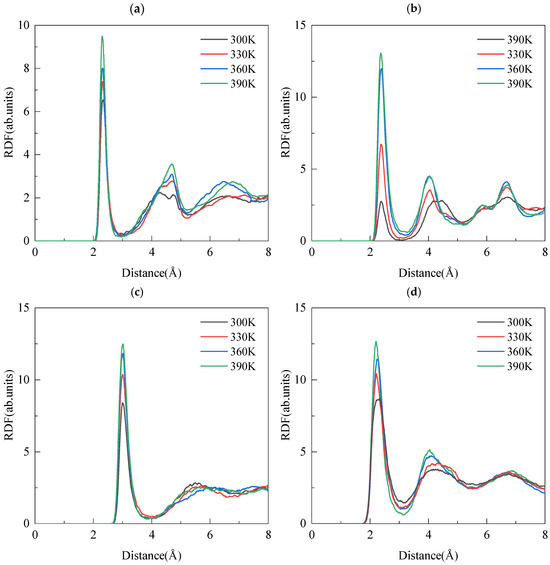
Figure 5.
Radial distribution function between solution and γ-FeOOH: (a) Na-Os pairs; (b) Na-Oh pairs; (c) Cl-Cas pairs; (d) Cl-Ho pairs.
Thus, high temperatures enhance the adsorption of Na and Cl ions by the C-S-H gel and γ-FeOOH, and it can be inferred that the excessive adsorption of Cl ions on the γ-FeOOH and C-S-H surface could disrupt the original interfacial bonding, as these aggressive ions occupy the bonding sites that have been initially held by other species. As a result, the interfacial stability would be compromised, and the degradation of the interfacial structure would be hastened.
3.3. Properties of Surface Calcium Ions
3.3.1. Surface Calcium Ions and the Matrix
The surface calcium ions of the C-S-H gel play a critical role in the interfacial bond between the C-S-H gel and the γ-FeOOH [25]. Figure 6 shows the radial distribution function (RDF) curves that illustrate the interactions between the Cas and the matrix, including the interactions between the Cas and the Ob in C-S-H gel and the Oh in γ-FeOOH, as respectively shown in Figure 6a,b. It can be observed from Figure 6a that as the temperature increases from 300 K to 390 K, a clear weakening trend of the interaction between the Cas and the Ob in the C-S-H gel is shown. Similarly, in Figure 6b, the interaction between Cas and Oh in γ-FeOOH weakens with increasing temperatures, and this is characterized by a decreasing trend of the peaks in the RDF curves. At elevated temperatures, aggressive ions such as Cl and Na would be strongly adsorbed by the C-S-H gel or the γ-FeOOH matrix. These aggressive ions compete for and occupy the original coordination sites around Cas that were initially involved in the bonding with Ob or Oh. As a result, the interaction between Cas and Ob/Oh is disrupted, leading to a reduction in the interfacial bonding network mediated by Cas, accelerating the degradation of the interface between the C-S-H gel and the γ-FeOOH. In summary, as the temperature increases, the interactions of the Cas-Ob and Cas-Oh are weakened, caused by the occupation of calcium ion coordination sites by aggressive ions (e.g., Cl, Na), leading to a decrease in the interfacial bond network and the degradation of the interface, which is consistent with the statement in Section 3.2.2.
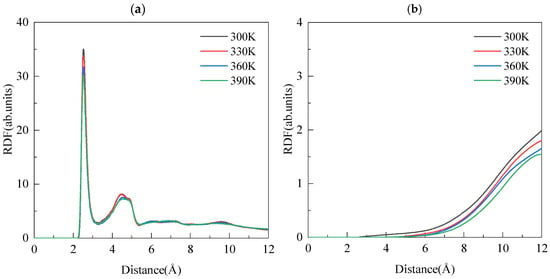
Figure 6.
Radial distribution function between Cas and matrix: (a) Cas-Ob pairs; (b) Cas-Oh pairs.
3.3.2. Surface Calcium (Inter), Interlayer Calcium (Intra) in C-S-H Gel
To investigate the effects of temperature elevation on the dynamic characteristics of surface calcium ions, Figure 7 shows the mean squared displacement (MSD) curves and the diffusion coefficients of surface calcium (Inter) and interlayer calcium (Intra) in the C-S-H gel. The dynamic properties can be estimated by the MSD and the diffusion coefficients (D), which can be calculated as
where ri(0) and ri(t) are respectively the position of atom i initially and at time t; n is the dimension of the calculated diffusion coefficient. As shown in Figure 7, on the one hand, the mobility of surface calcium ions exhibits a temperature-dependent increase, including significant increases in the MSD and diffusion coefficients. The enhanced mobility of surface calcium (Inter) in C-S-H gel suggests a reduction in the stability of their interfacial bridging role, making their coordination susceptible to replacement by aggressive ions. On the other hand, the mobility of the interlayer calcium (Intra) in C-S-H gel, represented by the MSD and diffusion coefficients, is rarely affected by the temperature. and for a certain temperature, the mobility of the interlayer calcium (Intra) is smaller than that of surface calcium (Inter). For example, the diffusion coefficients for the interlayer calcium (Intra) in C-S-H gel are about 0.30 × 10−9 m2/s with various temperatures of 300 K to 390 K, which is smaller than that of surface calcium ions (Inter) with values of about 0.50–1.15 × 10−9 m2/s as detailed in Table 2.
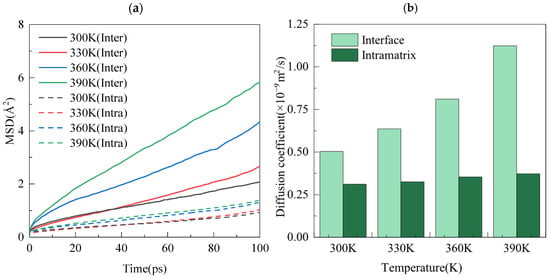
Figure 7.
Kinetic properties of calcium ions in C-S-H gel: (a) Mean squared displacement. (b) Diffusion coefficients.

Table 2.
Diffusion coefficients of surface calcium and interlayer calcium in the C-S-H gel.
In summary, Hou et al. [25] pointed out the mediating role of calcium ions in interface bonding, but they did not analyze the influence of temperature on the migration and bonding of calcium ions. Through the analysis of mean square displacement and diffusion coefficients, this study found that the mobility of surface calcium ions (Inter) increases significantly with an increase in temperature, while the mobility of interlayer calcium ions (Intra) is almost unaffected by temperature. Meanwhile, the increase in temperature will weaken the interactions between Cas and Ob, as well as between Cas and Oh. This finding clarifies the weakening mechanism of temperature on the mediating role of surface calcium ions and improves our understanding of the interface bonding network.
3.4. Hydrogen Bond Properties
According to the study of Fedotova [34], a pure geometric criterion for hydrogen bonds has been adopted in this study. That is, a hydrogen bond can be formed when the distance between the donor oxygen and acceptor oxygen is less than 3.5 Å, and the distance between the donor hydrogen and acceptor oxygen is less than 2.45 Å, with an angle between the donor oxygen, donor hydrogen, and acceptor oxygen of greater than 150°.
Figure 8 presents the probability distribution curves of hydrogen bond angles at the interface between C-S-H/γ-FeOOH and the solution, with the average data listed in Table 3. On the one hand, as the temperature increases, the peak value of the curve decreases, and the peak width increases. This observed transformation suggests that the hydrogen bond angles, which are crucial for maintaining the ordered structure, are succumbing to thermal agitation and becoming disordered. On the other hand, the hydrogen bond angles on the surfaces of both C-S-H and γ-FeOOH show a downward trend. As detailed in Table 3, when the temperature gradually increases from 300 K to 390 K, the average hydrogen bond angles on the surfaces of C-S-H and γ-FeOOH decrease from 165.04° to 164.09° and from 164.98° to 163.53°, respectively. Such a reduction in the hydrogen bond angles directly translates to a decrease in hydrogen bond stability.
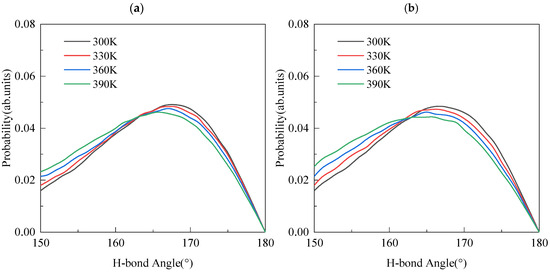
Figure 8.
Hydrogen bond angle distributions: (a) C-S-H/solution; and (b) γ-FeOOH/solution.

Table 3.
Averaged H-bond parameters at the interface under different temperatures.
The probability distribution curves of hydrogen bond lengths at the interface between C-S-H/γ-FeOOH and the solution are plotted in Figure 9 with the average value in Table 3. It can be seen that as the temperature increases, the peak value of the curve decreases and the peak width increases, indicating that hydrogen bonds tend to be stretched due to thermal effects. When the temperature increases from 300 K to 390 K, the hydrogen bond lengths on the C-S-H surface increase from 1.699 Å to 1.727 Å, and those on the γ-FeOOH surface increase from 1.786 Å to 1.828 Å. This indicates that the intermolecular forces between hydrogen bonds weaken, leading to reduced hydrogen bond stability and looseness. In addition, Table 3 indicates that the average number of hydrogen bonds also decreases with the temperature, causing the hydrogen bond network to be disrupted due to the enhanced thermal effects.
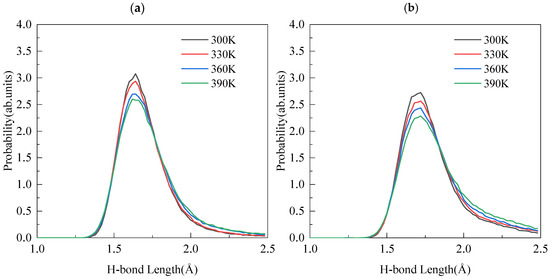
Figure 9.
Hydrogen bond length distributions: (a) C-S-H/solution; and (b) γ-FeOOH/solution.
Therefore, it can be concluded that as the temperature rises, the stability of hydrogen bonds at the interface decreases, and this is characterized by decreased hydrogen bond angles and numbers of hydrogen bonds but increased hydrogen bond lengths.
3.5. Interfacial Adsorption Energy
The interfacial bond performance can also be analyzed from an energy perspective through the interfacial adsorption energy (Eint) quantitatively representing the bond performance, which can be described as
where Etotal represents the total energy containing two different components labeled as “1” and “2”; E1 and E2 are respectively the energy of component 1 and component 2. The negative value of the interfacial adsorption energy indicates the presence of an attractive force between the two components, and the higher the absolute value, the stronger the attractive force.
Figure 10 shows the interaction energies between C-S-H/γ-FeOOH, C-S-H/solution, and γ-FeOOH/solution under the conditions of 300 K–390 K. It is shown that as the temperature increases, the interaction energies between various components in the system show a downward trend, indicating that a high temperature reduces the bond strength between C-S-H and γ-FeOOH. This is in good agreement with the phenomenon that the mechanical properties of steel fiber-reinforced concrete structures decrease in high-temperature environments [35,36]. In this study, based on the nanoscale insights from molecular dynamics simulations, it can be explained that at a temperature of 300 K, the influence of aggressive ions on the interface between C-S-H and γ-FeOOH is limited. In other words, under the effect of high adsorption energy, i.e., the condition of 300 K, the number of aggressive ions that can overcome the high adsorption energy barrier and occupy the surface calcium positions acting as connections is limited, resulting in a slow process of interface degradation. Under the action of high temperatures, the adsorption energy decreases, increasing the number of aggressive ions overcoming the high adsorption energy barrier, and meanwhile, the enhanced ion mobility facilitates interaction with surface calcium ions, further weakening the stability of interface connections. Therefore, the interfacial bond performance between C-S-H and γ-FeOOH significantly declines at high temperatures.
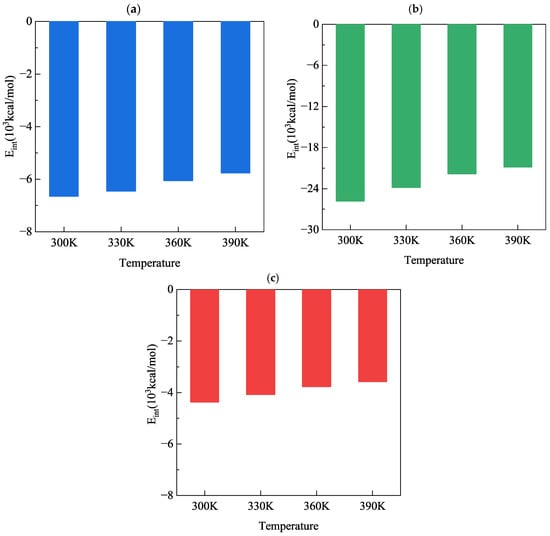
Figure 10.
The interaction energy per contact area: (a) γ-FeOOH and C-S-H; (b) C-S-H and solutions; and (c) γ-FeOOH and solutions at interfacial equilibrium.
In addition, high temperatures weaken the interaction energy between interfaces by enhancing the thermal movement ability of ions on the C-S-H surface, while the thermal movement ability inside the C-S-H is rarely affected by the temperature, as shown in Section 3.3.2. In other words, the interfacial transition zone of SFRC is a weak part. Hence, it can be concluded that in an aggressive environment, the SFRC first undergoes interfacial bond failure, followed by failure due to insufficient bearing capacity of the concrete. This conclusion is in good agreement with the macroscopic test results as reported in existing studies [37,38], where biaxial punching tests demonstrate that the microstructure of SFRC undergoes significant changes (e.g., formation of initial microcracks) under high-temperature conditions, accompanied by a marked degradation in mechanical properties. Similarly, existing studies [39,40] also report that the degradation of mechanical properties in fiber-reinforced cement-based composites and recycled plastic aggregate concrete at elevated temperatures is attributed to the weakening of the interfacial transition zone. In this study, molecular dynamics simulations further quantify the microscopic mechanism governing the reduction in interfacial energy, thereby providing a theoretical basis for the macroscopic observations reported in earlier studies [37,38,39,40].
To validate the universality of the research findings, this study has also extended the simulation time from the original 100 ps to 300 ps for comparative analysis. All simulations have been conducted under the microcanonical ensemble (NVT) at four temperature conditions: 300 K, 330 K, 360 K, and 390 K. The simulation time step has been set to 1 fs, with data output every 100 steps. The variation patterns of interparticle interaction energy at the C-S-H/γ-FeOOH interface under the two simulation durations are presented in Table 4. It is indicated that when the simulation time extends from 100 ps to 300 ps, the trend of interfacial interaction energy decreasing with increasing temperature remains consistent, exhibiting a significant decline. This finding confirms the stability of the conclusions with respect to simulations’ duration, demonstrating the general applicability of the obtained results.

Table 4.
Interfacial adsorption energy under different temperatures.
4. Conclusions
This study systematically investigates the temperature-driven degradation mechanisms of the C-S-H/γ-FeOOH interface in NaCl solution environments (300 K–390 K) using molecular dynamics simulations, revealing that elevated temperatures significantly weaken interfacial bond performance through nanoscale physicochemical changes. The key findings are summarized as follows:
(1) High temperatures reduce the stability of hydration shells surrounding aggressive ions (Na+ and Cl−), enabling these ions to directly interact with the C-S-H/γ-FeOOH interface. They competitively occupy the original coordination sites of surface calcium ions, forming stable ion pairs with surface calcium ions and disrupting the intrinsic interfacial bonding network.
(2) Elevated temperatures remarkably increase the mobility of surface calcium ions in C-S-H. This heightened thermal motion weakens the interaction strength of surface calcium ions with Ob in C-S-H and Oh in γ-FeOOH, diminishing the mediating role of surface calcium ions in maintaining interfacial connections.
(3) Thermal agitation leads to a decrease in hydrogen bond angles and numbers at the interface, accompanied by an increase in hydrogen bond lengths. This structural disorder reduces the stability of the hydrogen bond network, further loosening the interfacial cohesion.
Collectively, these nanoscale changes, i.e., the ion competition, enhanced calcium ion mobility, and decreased hydrogen bond stability, result in a significant reduction in interfacial adsorption energy, ultimately degrading the bond performance of the C-S-H/γ-FeOOH interface. Based on the above research findings, to enhance the durability of SFRC under the coupled effects of NaCl environments and elevated temperatures, the following strategies can be adopted: (1) improving the stability of the passive film by incorporating corrosion inhibitors or corrosion-resistant steel fibers; and (2) mitigating thermal-induced damage to the interfacial transition zone (ITZ) through thermal insulation materials or optimized curing regimes. Furthermore, future research should integrate multiscale simulations with experimental validation to investigate the synergistic effects of complex environmental factors, thereby further improving reliability in engineering applications.
Author Contributions
Conceptualization, J.M. and W.S.; methodology, J.M. and W.S.; software, J.X., J.M. and W.S.; validation, J.X., J.M. and W.S.; formal analysis, J.X. and J.W.; investigation, J.X. and J.W.; resources, J.X. and J.W.; data curation, J.X., J.M. and W.S.; writing—original draft preparation, J.X., J.M. and W.S.; writing—review and editing, J.X. and J.W.; visualization, J.M. and W.S.; supervision, J.W. and J.X.; project administration, J.X. and J.W.; funding acquisition, J.W. All authors have read and agreed to the published version of the manuscript.
Funding
This research was funded by National Natural Science Foundation of China, grant number 52478114.
Data Availability Statement
The original contributions presented in this study are included in the article. Further inquiries can be directed to the corresponding author.
Conflicts of Interest
Author Jianchao Xu was employed by the China Academy of Railway Sciences Corporation Limited. The remaining authors declare that the research was conducted in the absence of any commercial or financial relationships that could be construed as a potential conflict of interest.
Correction Statement
This article has been republished with a minor correction to the Data Availability Statement. This change does not affect the scientific content of the article.
References
- Du, F.Y.; Jin, Z.Q.; She, W.; Xiong, C.S.; Feng, G.Y.; Fan, J.F. Chloride ions migration and induced reinforcement corrosion in concrete with cracks: A comparative study of current acceleration and natural marine exposure. Constr. Build. Mater. 2020, 263, 120099. [Google Scholar] [CrossRef]
- Pour-Ghaz, M.; Isgor, O.B.; Ghods, P. The effect of temperature on the corrosion of steel in concrete. Part 1: Simulated polarization resistance tests and model development. Corros. Sci. 2009, 51, 415–425. [Google Scholar] [CrossRef]
- Nasir, A.; Butt, F.; Ahmad, F. Enhanced mechanical and axial resilience of recycled plastic aggregate concrete reinforced with silica fume and fibers. Innov. Infrastruct. Solut. 2025, 10, 4. [Google Scholar] [CrossRef]
- Ji, Y.S.; Zhan, G.M.; Tan, Z.C.; Hu, Y.J.; Gao, F.R. Process control of reinforcement corrosion in concrete. Part 1: Effect of corrosion products. Constr. Build. Mater. 2015, 79, 214–222. [Google Scholar] [CrossRef]
- Ji, Y.S.; Wu, M.; Tan, Z.C.; Gao, F.R.; Liu, F. Process control of reinforcement corrosion in concrete. Part 2: Time-dependent dominating factors under different environmental conditions. Constr. Build. Mater. 2014, 73, 214–221. [Google Scholar] [CrossRef]
- Ogunsanya, I.G.; Hansson, C.M. Influence of chloride and sulphate anions on the electronic and electrochemical properties of passive films formed on steel reinforcing bars. Materialia 2019, 8, 100491. [Google Scholar] [CrossRef]
- Wu, J.; Sang, W.; Li, D.; Jin, L. Molecular dynamics simulation of temperature effects on sodium chloride solution adsorption in γ-FeOOH nanopores. Constr. Build. Mater. 2024, 449, 138410. [Google Scholar] [CrossRef]
- Ahmad, F.; Rawat, S.; Yang, R.C.; Zhang, L.H.; Zhang, Y. Fire resistance and thermal performance of hybrid fibre-reinforced magnesium oxychloride cement-based composites. Constr. Build. Mater. 2025, 472, 140867. [Google Scholar] [CrossRef]
- Jin, L.; Yang, J.; Wu, J.; Du, X. Probabilistic prediction model of fatigue life of RC structures considering the meso-scale inhomogeneity of concrete. Mater. Rep. 2024, 38, 23090009. (In Chinese) [Google Scholar]
- Alizade, E.; Jandaghi, A.F.; Zabihi, S. Effect of steel fiber corrosion on mechanical properties of steel fiber reinforced concrete. Asian J. Civ. Eng. 2016, 17, 147–158. [Google Scholar]
- Yang, D.; Ren, X.; Gao, Y.; Fan, T.; Li, M.; Lv, H. Study on the Basic Mechanical Properties of Waste Steel Fiber Reinforced Concrete After High-Temperature Exposure. Buildings 2025, 15, 1025. [Google Scholar] [CrossRef]
- Ismail, R.; Zakwan, F.A.A.; Petrus, C.; Marzuki, N.A.; Hashim, N.H.; Mustafa, M.F. Compressive Behavior of Steel Fiber Reinforced Concrete After Exposed to High Temperatures; Springer: Singapore, 2014; pp. 731–740. [Google Scholar]
- Yang, J.Y.; Shen, A.Q.; Lyu, Z.H.; Wang, L.S.; Wu, H.; Tian, F. Chloride permeability and deterioration mechanism of pavement concrete under load-temperature coupling. Arab. J. Sci. Eng. 2023, 48, 4227–4243. [Google Scholar] [CrossRef]
- Zhou, Y.; Hou, D.S.; Jiang, J.Y.; Liu, L.; She, W.; Yu, J. Experimental and molecular dynamics studies on the transport and adsorption of chloride ions in the nano-pores of calcium silicate phase: The influence of calcium to silicate ratios. Microporous Mesoporous Mater. 2018, 255, 23–35. [Google Scholar] [CrossRef]
- Kumar Mehta, P.; Monteiro, P.J.M. Concrete: Microstructure, Properties, and Materials; McGraw-Hill Professional: New York, NY, USA, 2006; p. 28. [Google Scholar]
- Vayer, M.; Reynaud, I.; Erre, R. XPS characterisations of passive films formed on martensitic stainless steel: Qualitative and quantitative investigations. J. Mater. Sci. 2000, 35, 2581–2587. [Google Scholar] [CrossRef]
- Deng, H.Y.; He, Z. Interactions of sodium chloride solution and calcium silicate hydrate with different calcium to silicon ratios: A molecular dynamics study. Constr. Build. Mater. 2021, 268, 121067. [Google Scholar] [CrossRef]
- Wang, F.J.; Zhang, Y.; Jiang, J.Y.; Yin, B.; Li, Z.J. Effect of temperature on the capillary transport of sodium sulfate solution in calcium silicate hydrate nanopore: A molecular dynamics study. Constr. Build. Mater. 2020, 231, 117111. [Google Scholar] [CrossRef]
- Fei, X.P.; Guo, L.P.; Wu, J.D.; Lyu, B.C.; Chu, Y.J.; Shen, X.Y. Impact of temperature, pH value and multiple ions on the physisorption of chloride ion on C-S-H gel surface. Constr. Build. Mater. 2023, 392, 131967. [Google Scholar]
- Tong, T.T.; Li, Z.L.; Shang, H.B. Penetration characteristics of water in calcium silicate hydrate nanoslit and temperature effect. Mol. Simul. 2023, 49, 1502–1511. [Google Scholar] [CrossRef]
- Im, S.; Jee, H.; Suh, H.; Kanematsu, M.; Morooka, S.; Taku, K.; Yuhei, N.; Machida, A.; Kim, J.; Bae, S. Temperature effects on local structure, phase transformation, and mechanical properties of calcium silicate hydrates. J. Am. Ceram. Soc. 2021, 104, 4803–4818. [Google Scholar] [CrossRef]
- Wang, X.F.; Li, T.R.; Wei, P.; Li, D.W.; Han, N.X.; Xing, F.; Gan, Y.; Chen, Z. Computational study of the nanoscale mechanical properties of C-S-H composites under different temperatures. Comput. Mater. Sci. 2018, 146, 42–53. [Google Scholar] [CrossRef]
- Tu, Y.M.; Yuan, L.; Liu, D.Y.; Cao, J.; Ding, Y.H.; Das, O.; Försth, M.; Sas, G.; Elfgren, L. Molecular dynamics simulations of chloride and sulfate ion transport in C-S-H gel and γ-FeOOH nanopores. J. Adv. Concr. Technol. 2022, 20, 720–731. [Google Scholar] [CrossRef]
- Tian, Z.S.; Kang, X.J.; Ji, H.D.; Ye, H.L. Quantitative relationship between microstructure of steel-concrete interface and chloride-induced corrosion rate of steel in unsaturated cementitious materials. Cem. Concr. Res. 2025, 188, 107736. [Google Scholar] [CrossRef]
- Hou, D.S.; Xu, X.Q.; Wang, M.H.; Chen, Z.; Zhang, J.R.; Dong, B.Q.; Miao, J.; Liu, C. Nanoscale insights on the interface between passive film of steel and cement hydrate: Diffusion, kinetics and mechanics. Appl. Surf. Sci. 2020, 514, 145898. [Google Scholar] [CrossRef]
- Zhang, L.Z.; Wang, R.A.; Luan, Y.L.; Wang, H.; Tong, H. Molecular dynamics study on bonding behaviors of γ-FeOOH/CSH interface under aggressive conditions. Appl. Surf. Sci. 2025, 680, 161342. [Google Scholar] [CrossRef]
- Pellenq, R.J.M.; Kushima, A.; Shahsavari, R.; Van Vliet, K.J.; Buehler, M.J.; Yip, S.; Ulm, F.J. A realistic molecular model of cement hydrates. Proc. Natl. Acad. Sci. USA 2009, 106, 16102–16107. [Google Scholar] [CrossRef]
- Hou, D.S.; Zhang, J.R.; Li, Z.J.; Zhu, Y. Uniaxial tension study of calcium silicate hydrate (C-S-H): Structure, dynamics and mechanical properties. Mater. Struct. 2015, 48, 3811–3824. [Google Scholar] [CrossRef]
- Pan, T.Y.; Lu, Y. Quantum-chemistry based studying of rebar passivation in alkaline concrete environment. Int. J. Electrochem. Sci. 2011, 6, 4967–4983. [Google Scholar] [CrossRef]
- Pan, T.Y.; van Duin, A.C.T. Passivation of steel surface: An atomistic modeling approach aided with X-ray analyses. Mater. Lett. 2011, 65, 3223–3226. [Google Scholar] [CrossRef]
- Christensen, H.; Christensen, A.N. Hydrogen-Bonds of Gamma-Feooh. Acta Chem. Scand. 1978, 32, 87–88. [Google Scholar] [CrossRef]
- Hou, D.; Zhang, K.; Hong, F.; Wu, S.R.; Wang, Z.; Li, M.; Wang, M. The corrosion deterioration of reinforced passivation Film: The impact of defects. Appl. Surf. Sci. 2022, 582, 152408. [Google Scholar] [CrossRef]
- Ahmad, F.; Rawat, S.; Yang, R.; Zhang, L.; Fanna, D.J.; Soe, K.; Zhang, Y.X. Effect of metakaolin and ground granulated blast furnace slag on the performance of hybrid fibre-reinforced magnesium oxychloride cement-based composites. Int. J. Civ. Eng. 2025, 23, 853–868. [Google Scholar] [CrossRef]
- Fedotova, M.V. Effect of temperature and pressure on structural self-organization of aqueous sodium chloride solutions. J. Mol. Liq. 2010, 153, 9–14. [Google Scholar] [CrossRef]
- Dügenci, O.; Haktanir, T.; Altun, F. Experimental research for the effect of high temperature on the mechanical properties of steel fiber-reinforced concrete. Constr. Build. Mater. 2015, 75, 82–88. [Google Scholar] [CrossRef]
- Çelik, Z.; Urtekin, Y. Effects of high temperature and water re-curing on the flexural behavior and mechanical properties of steel-basalt hybrid fiber-reinforced concrete. Appl. Sci. 2025, 15, 1587. [Google Scholar] [CrossRef]
- Kim, J.; Lee, G.P.; Moon, D.Y. Evaluation of mechanical properties of steel-fibre-reinforced concrete exposed to high temperatures by double-punch test. Constr. Build. Mater. 2015, 79, 182–191. [Google Scholar] [CrossRef]
- Xiao, J.Z.; Xie, Q.H.; Xie, W.G. Study on high-performance concrete at high temperatures in China (2004–2016)—An updated overview. Fire Saf. J. 2018, 95, 11–24. [Google Scholar] [CrossRef]
- Ahmad, F.; Qureshi, M.I.; Rawat, S.; Alkharisi, M.K.; Alturki, M. E-waste in concrete construction: Recycling, applications, and impact on mechanical, durability, and thermal properties—A review. Innov. Infrastruct. Solut. 2025, 10, 246. [Google Scholar] [CrossRef]
- Rawat, S.; Saliba, P.; Estephan, P.C.; Ahmad, F.; Zhang, Y. Mechanical performance of hybrid fibre reinforced magnesium oxychloride cement-based composites at ambient and elevated temperature. Buildings 2024, 14, 270. [Google Scholar] [CrossRef]
Disclaimer/Publisher’s Note: The statements, opinions and data contained in all publications are solely those of the individual author(s) and contributor(s) and not of MDPI and/or the editor(s). MDPI and/or the editor(s) disclaim responsibility for any injury to people or property resulting from any ideas, methods, instructions or products referred to in the content. |
© 2025 by the authors. Licensee MDPI, Basel, Switzerland. This article is an open access article distributed under the terms and conditions of the Creative Commons Attribution (CC BY) license (https://creativecommons.org/licenses/by/4.0/).